| Life
in East Germany, 1949-1989 (back to top)
- Mr. Fawcett began with images of the devastation wreaked on the cities
and infrastructure by the Allied bombing raids, as well as the block-by-block
combat necessitated by the Germans' hopeless last-ditch resistance effort
(primarily in Berlin).
- Mass rape by Soviet soldiers did not endear the later "big
brother" to the East German populace. According to Antony Beevor
in Berlin: The Downfall 1945 (2002):
"Estimates
of rape victims from [Berlin's] two main hospitals ranged from 95,000
to 130,000. One doctor deduced that out of approximately 100,000
women raped in the city, some 10,000 died as a result, mostly from
suicide. The death rate was thought to have been much higher among
the 1.4 million estimated victims in East Prussia, Pomerania and
Silesia. Altogether at least two million German women are thought
to have been raped, and a substantial minority, if not a majority,
appear to have suffered multiple rape."
(Quotation from a May
1, 2002 Guardian article)
- Once the war was over, much of the infrastructure that hadn't been
destroyed was taken as reparations by the Soviet occupying power, which
was eager to compensate for the vast devastation of its own infrastructure
under the Nazis' "scorched earth" policy.
- Next came an overview of the East German regime's contradictions between
propaganda and practice in the 1950s and 1960s, such as
- the re-use of Nazi concentration camps as Soviet NKVD "special
camps" to imprison both former Nazis and anti-Nazis who objected
to
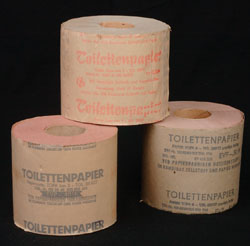 policies
of the SED. In the late 1950s and early 1960s the former camps were
converted into memorial sites idolizing the Communist heros who
fought against the Nazis. policies
of the SED. In the late 1950s and early 1960s the former camps were
converted into memorial sites idolizing the Communist heros who
fought against the Nazis.
- Fawcett finished with wonderful images of East German consumer products,
including an ad that proudly proclaimed "unchanged for 40 years"
(IMI laundry detergent). Illustrations can be found in:
- Ernst Hedler (photos) and Ralf Ulrich (introduction), DDR
Design / East German design / design de la RDA, 1949-1989 (Cologne,
Los Angeles: Taschen, 2004), 191 p. ($10
at amazon)
- Illustrations of products available for purchase at the "ostalgie"
sites osthits.de,
and ostprodukteladen.de.
- A google
image search of 'DDR Produkte' will get you a sampling of images.
- The largest collection of images on the web is probably the Sammlung
zur DDR-Alltagskultur. Click on the categories in the left frame
and you can scroll through images of that product in the right frame.
Knowing German may help in choosing categories.
- Still more images can be found at DDR Museums, such as the one
in Dutch Monnickendam
(10 km n. of Amsterdam), or in (former) East German Malchow
(on the A19 not far north of Berlin; scroll
 down
for images in the right-hand column). down
for images in the right-hand column).
- He had many great anecdotes, including how there was a special uninterrupted
radio broadcast of popular Western albums from 4-5pm each day. Special
radio-cassette recorders were sold, so that young people could tape
the albums, thereby avoiding the need for hard currency (or any currency
at all) to purchase the music.
- "Bückwaren"--'bend-over goods'--were limited-release
items that shop clerks kept under the counter and bent over to retrieve
only for special customers. Our usual "customer is king"
mantra was reversed in East Germany: customers had to be nice to
the clerks in order to have access to special items.
- East Germans of course had access to Western TV stations. On both
Eastern and Western evening news broadcasts a ticking clock was
shown to mark the full hour. Teachers could ask young children "does
the clock on your TV have dots or lines to mark the hours?"
and thereby tell whether the parents were watching Eastern or Western
TV news.
- Dresden is located in the Elb river valley and was not able receive
Western broadcasts. It was thus known as the "valley of the
clueless" (Tal der Ahnungslosen).
[In 2003 Nigerian-East German filmmaker Branwen
Okpako made a drama about the Stasi with that title; it is set in
Dresden. (The connection is unclear from the plot
summary.)]
- Singer-songwriter-dissident Wolf Biermann (1936-) was "dumped"
into West Germany in 1976 when the East Germans couldn't shut him
up anymore.
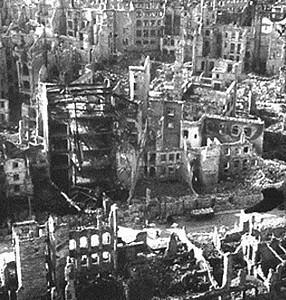 |
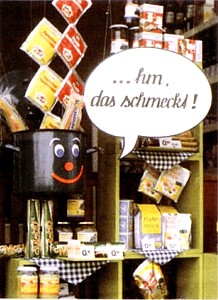 |
|
The ruins of
Dresden in 1945 |
East German window
display of babyfood: 'Hm, tastes good!'
|
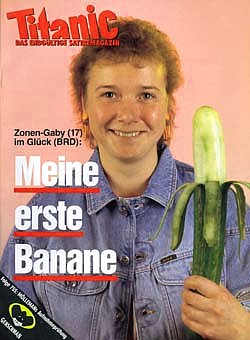
|
Mr.
Fawcett concluded his lecture with this image.
The November
1989 issue of the West German satirical magazine Titanic
featured "Zonen-Gabi in ecstasy" (Zone being short for
'Soviet Zone,' and Gabi a common girl's name) eating "My first
banana," which is actually a peeled cucumber.
The satire is
based on the East Germans having had to settle for inferior surrogate
goods because the country did not want to spend its hard currency
on consumer imports. In the first days after Nov. 9, West Germans
gave East Germans bananas to try, often throwing them into the crowds,
as people might do to animals at a zoo.
The poster reminds
me of the scene in The Promise where Konrad paints a stuffed
Panda bear brown so that his daughter will think the bears in the
East Berlin zoo are pandas. |
- I tried to get accurate figures on the extent of Stasi collaboration.
From Mary Fulbrook's The People's State: East German Society from
Hitler to Honecker (2005), 241-47 I gleaned the following:
- 1989: 91,000 full-time Stasi employees for total GDR population
of 16.4 million: 0.55%
By comparison: 7,000 full-time Gestapo for 66 mio--but they could
rely on lots of cooperation by a populace willing to inform on its
neighbors
- Informal Stasi agents (IMs):
1950s: 20,000-30,000
1968: 100,000
1975-1989: 170,000-180,000 (proportion: 1 for every 60 adults [10,500,000
adults]).
- Stasi's own figures suggest a 10% turnover each year, or about
17,500 new agents. Thus over time Fulbrook estimates about 500,000
East Germans were at one time IMs.
- Reasons for collaborating:
- members of the SED (true believers; in one instance in 1962:
40-50% of all IMs)
- "probably a majority" were willing or persuaded
to cooperate by small advantages, social rewards, material inducements,
or a sense of adventure or flattery
- less than 10% (Stasi says 7.7%): obvious coercion, bullying
- Another source says the Stasi kept files on 4 mio. East Germans
and 2 million West Germans. 1,500 Stasi spies were active in West
Germany.
- stasiopfer.de
(in German) has relatively detailed information.
|
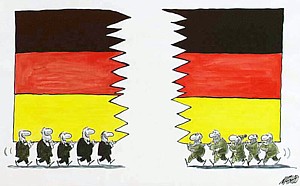
 policies
of the SED. In the late 1950s and early 1960s the former camps were
converted into memorial sites idolizing the Communist heros who
fought against the Nazis.
policies
of the SED. In the late 1950s and early 1960s the former camps were
converted into memorial sites idolizing the Communist heros who
fought against the Nazis. down
for images in the right-hand column).
down
for images in the right-hand column).


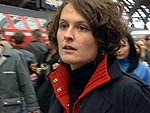 :
: